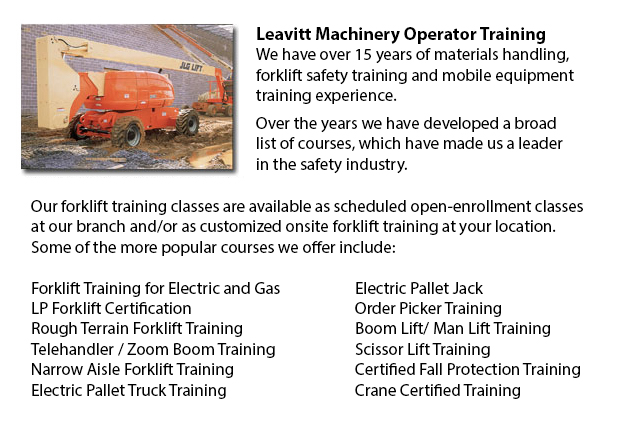
Saskatoon Boom Lift Certification - Elevated work platforms allow maintenance operations and work to be carried out at levels that could not be reached by whichever other means. Workers making use of scissor lifts and boom lifts could be educated in the safe operation of these devices by receiving boom lift certification training.
When work platforms are operated unsafely, they have the possibility for serious injury and even death, regardless of their lift style, application or the site conditions. Falls, electrocution, crushed body parts, and tip-overs could be the unfortunate result of improper operating procedures.
To avoid aerial lift accidents, individuals have to be qualified to be able to train workers in the operation of the certain kind of aerial lift they would be making use of. Controls should be easily accessible beside or in the platform of boom lifts made use of for carrying workers. Aerial lifts should not be be altered without the express permission of the manufacturer or other recognized entity. If you are leasing a lift, make sure that it is maintained correctly. Before utilizing, controls and safety devices should be inspected to be able to make sure they are working correctly.
Operational safety procedures are essential in avoiding accidents. Operators must not drive an aerial lift with an extended lift (although a few are designed to be driven with the lift extended). Always set brakes. Set outriggers, if available. Avoid slopes, but when needed make use of wheel chocks on slopes which do not exceed the slope restrictions of the manufacturer. Follow manufacturer's load and weight limitations. When standing on the platform of boom lifts, utilize full-body harnesses or a safety belt with a two-foot lanyard tied to the basket or boom. Fall protection is not required for scissor lifts that have guardrails. Do not sit or climb on guardrails.
This course consists of the following topics: safety guidelines to prevent a tip-over; training and certification; checking the work area and travel path; slopes and surface conditions; stability factors; other tips for maintaining stability; weight capacity; leverage; testing control functions; pre-operational inspection; mounting a vehicle; safe operating practices; safe driving procedures; overhead obstacles and power lines; PPE and fall protection; using harnesses and lanyards; and avoid falling from the platform.
When successful, the trained employee would be familiar with the following: pre-operational inspection procedures; training and authorization procedures; how to avoid tip-overs; factors affecting the stability of boom and scissor lifts; how to utilize PPE, how to utilize the testing control functions and strategies to avoid falls.
-
Saskatoon Telehandler License
Saskatoon Telehandler License - The telescopic handler or telehandler is a frequently utilized machine in agricultural and industrial applications. This particular equipment is similar in appearance to a forklift and even functions in a similar way,... More -
Saskatoon Zoom Boom Ticket
Saskatoon Zoom Boom Ticket - Zoom Boom Training focuses on correctly training prospective operators on variable reach forklifts. The training objectives consist of gaining the knowledge of the machine's physics and to define the job of the operator.... More -
Saskatoon Forklift Operator Training
Saskatoon Forklift Operator Training - In North America, lift truck operator training is needed in order to prevent workplace injuries and accidents. Particular lift truck training will be provided to offer forklift operators driver training. The saf... More -
Saskatoon Forklift Certification Schools
Saskatoon Forklift Certification Schools - Forklift Certification is mandatory in North America. Hence, forklift training programs are essential both for businesses and for individuals seeking jobs in industries as forklift operators. Forklift traini... More -
Saskatoon Telehandler Training Courses
Saskatoon Telehandler Training Courses - Employers are responsible for making certain that their operating personnel and supervisors are trained to work competently utilizing telehandler machines. The competence level of staff must be assessed. If de... More -
Saskatoon Boom Lift Training
Saskatoon Boom Lift Training - Aerial platforms or likewise known as elevated work platforms are devices that enable workers to perform tasks and duties at elevated heights that will not be otherwise accessible. There are many aerial lifts available... More -
Crane / Overhead Crane / Self-Erect Crane / Truck Mounted Crane / Hydraulic Cranes Training in Saskatoon
Overhead cranes are likewise referred to as bridge cranes. They are a type of crane which comprises a line and hook device that runs along a horizontal beam which runs along two widely separated rails. Several overhead cranes can be found within a lo... More -
Saskatoon Heavy Equipment Training Programs
Saskatoon Heavy Equipment Training Programs - At any given construction site, there are usually different types of machinery which are ready to be used. These light and heavy machinery require both operators to run them and mechanics to fix them. Tra... More

Forklift Certification Saskatoon
TOLL FREE: 1-888-254-6157
Saskatoon, Saskatchewan
forkliftcertificationsaskatoon.com
Email Us
About Us


